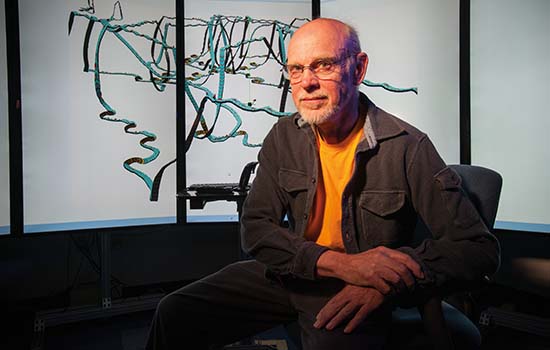 |
 |
| current issue |  | past issues |  | send a letter/news |  | address update |  | advertise |  | about us |  | alumni home |
|
Inquiring Minds By Chelsea Conaboy '04 |
|
In this issue:
Odd CoupleAncient Buzz
Deep Data
Odd Couple
Squid symbiosis gives bacteria a good name.
 Kahikai.org |
Cheryl Whistler is enchanted by her research subject, the Hawaiian bobtail squid. When she describes the petite sea creature, it's easy to see why. About the size of a walnut, the squid can adjust tiny organs in its skin to change color. The squid are freckled, with big eyeballs, and small flaps of skin that look like wings.
"They really are charismatic," says Whistler, associate professor of microbiology and genetics.
But perhaps the most enchanting feature can't be claimed by the squid alone.
Bioluminescent bacteria known as vibrio fischeri live in an organ on the squid's underside. These bacteria feed off nutrients provided by the squid and, in turn, protect it. The light they emit acts as camouflage, hiding the squid's silhouette so that predators trolling the depths below can't see the squid when they look toward the surface of the water. Instead of a delectable morsel, all they see is moonlight.
Whistler and colleague Vaughn Cooper have won a three-year, $716,000 grant from the National Science Foundation to further research the symbiotic relationship between the bobtail squid and V. fischeri. While this symbiotic coupling has been well studied,Whistler and Cooper will build on the current body of work to determine how nonsymbiotic strains of the bacterium develop the ability to colonize juvenile squid to create the optimal host-microbe relationship, even if they never have lived with squid before.
"None of [the bacteria] have gotten new genetic material," Whistler says. "They're just playing with what they've got and making adjustments."
Although most people think only of the microbes that cause disease, Whistler notes that "beneficial bacteria are the foundation of health of all plants and animals, including humans." Because most research has focused on disease-causing bacteria, these beneficial associations aren't well understood. Whistler notes that researchers and the general public are beginning to appreciate the benefits of certain microbes. The squid is a good ambassador of that message.
Whistler thinks the squid research will add to the broader understanding of how microbes adapt to their host. "The vast majority of microbes out there are not causing any harm and probably doing a lot of good, without any credit," she says.
Ancient Buzz
A modern model for prehistoric bees.
When the dinosaurs died off 65 million years ago, they left clues behind, their fossils scattered around the world in bits and pieces and, sometimes, entire skeletons. From the same period, there are few fossilized bees that scientists can use to deduce how the insects lived and died. Working with colleagues in Australia, Sandra Rehan, an assistant professor of biological sciences, has used DNA sequencing of modern species to model how bees evolved near the end of the Cretaceous period. In a study published in October by the Public Library of Science journal, PLoS ONE, Rehan and her colleagues examined four lineages of carpenter bees and found that each indicated a fate similar to that of dinosaur contemporaries: mass extinction.
Today, bees are incredibly diverse. In September, scientists identified the 20,000th distinct species. But about 66 million years ago, there was a "genetic bottleneck" due to die off, Rehan says.
"Up to 90 percent of diversity was lost, and we don't have the fossils to determin what species went extinct at that time," she says. "All we have is the living species that we can study now."
Rehan began charting the genetic makeup of species and how they are related to one another to develop a kind of bee family tree, a practice called molecular phylogenetics. She and co-authors Remko Leys and Michael Schwarz of Flinders University of South Australia used fossilized bees that have been found—most much younger than 66 million years—as a sort of "calibration point," to understand the pace of evolution that led to modern species. They followed the model backward in time and found that the pattern of extinction held for all four bee groups. "The data told us something major was happening in four different groups of bees at the same time," Rehan says. "And it happened to be the same time as the dinosaurs went extinct."
The idea that bees died en masse during this period—a time scientists had already documented as coinciding with the extinction of the flowering plants on which they would have depended—seems intuitive. But, Rehan says, this study provided the first evidence.
Today, bee colonies are struggling. It's not clear why, though insecticides and pathogens likely play a role. The picture Rehan and her colleagues paint from tens of millions of years ago may not provide any clarity about the cause. But, the authors write, it might shed light on how bees could evolve today to cope with widespread species collapse.
"Understanding extinctions and the effects of declines in the past can help us understand the global crisis in pollinators today, " Rehan says.
 Perry Smith/UNH Photographic Services DEEP DATA: It may look like a roller coaster or a video game, but the 3-D map behind Colin Ware, director of data visualization research at UNH's Center for Coastal and Ocean Mapping, is serious business. In the fall, Ware published research tracking the movements of humpback whales in the southern Gulf of Maine that illustrated the animals' heretofore unknown preference for bottom feeding. Because entanglement with fishing gear is a major threat to humpbacks, Ware's findings have implications for "bottom-set" techniques—such as those used in lobstering—in the region. Ware and his collaborators affixed suction-cupped recording tags to the whales' backs to gather the data, which revealed not only feeding behaviors but also the animals' highly acrobatic aquatic travels. |
blog comments powered by Disqus

